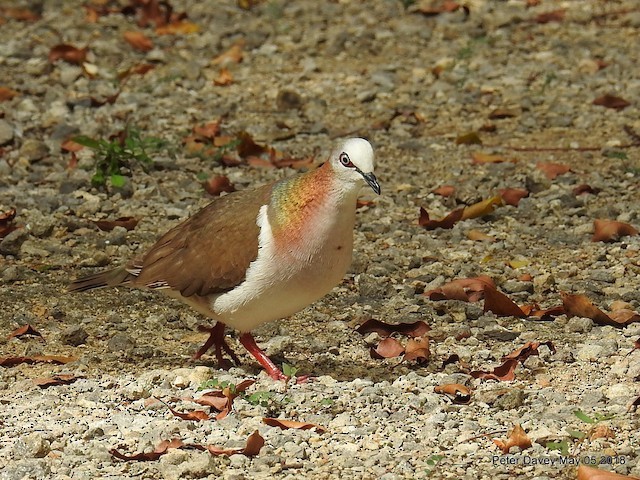Birdfinding.info ⇒ On Jamaica, easily observed at close range at Rocklands Bird Sanctuary. Usually present at several sites, including Treasure Beach, Stewart Town, Marshall’s Pen, Portland Ridge, Robin’s Bay, and San San. On New Providence, The Retreat National Park is a reliable site. Uncommon on Grand Cayman, but can be found at Botanic Park, the Mastic Trail, and North Side.
Caribbean Dove
Leptotila jamaicensis
Yucatán Peninsula and western Caribbean islands: the Honduran Bay Islands; the Cayman Islands; Jamaica; Isla San Andrés (i.e., the Colombian offshore territory 170 km east of central Nicaragua); and New Providence (Bahamas; where introduced).
Inhabits various types of woodland, brush, and tall scrub. On Jamaica, widespread across all elevations up to cloud forest, but most numerous in dry lowlands.
Caribbean Dove (Leptotila jamaicensis) is here provisionally subdivided into three distinct forms:
“Red-necked Dove” (L. j. jamaicensis) of Jamaica, New Providence, and the Cayman Islands (collaris).
“Yucatán Dove” (L. j. gaumeri) of the Yucatán Peninsula and the Bay Islands.
“San Andrés Dove” (L. j. neoxena) of Isla San Andrés.
(Reasons for this subdivision are explained in the Notes below: Frontiers of Taxonomy: Caribbean Dove. The remainder of this page primarily describes the “Red-necked Dove.” For more detailed information on the Yucatán and San Andrés forms, follow the links.)
Identification
The subspecies of Caribbean Dove vary widely in appearance. All have brown upperparts, a white face, deep red orbital skin, blue-gray hindcrown, multicolored iridescence around the nape, and coral-red legs.
They differ most conspicuously in the presence or absence of a bold white bar on the sides of the chest, the ground color of the neck and breast, and the shades of iridescence on the neck and upper back.
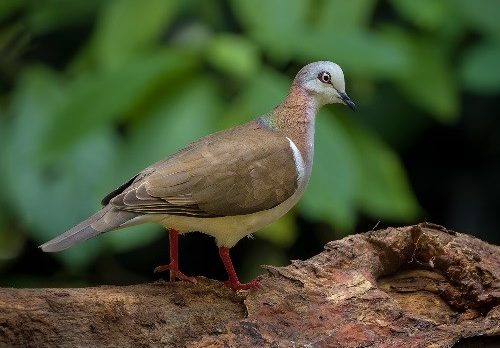
“Red-necked Dove,” L. j. jamaicensis, showing mostly coppery iridescence on the sides of the neck, with bronze, green, and blue on the upper back. (Rocklands Bird Sanctuary, Jamaica; February 2012.) © Ignacio Yúfera
“Red-necked Dove.” The nominate jamaicensis of Jamaica (and introduced to New Providence) has a rich reddish swath across the nape and sides of the neck, immaculate white belly, and bold white bar on the side of its chest that is often prominent in front of the folded wing.
The neck and upper back show a range of iridescent colors: coppery to magenta on the sides of the neck, yellowish or bronzy on the hindneck, becoming greenish, then bluish on the back.

“Red-necked Dove,” L. j. jamaicensis, showing blue hindcrown and magenta iridescence on the sides of the neck. (Silver Hill Gap, Jamaica; February 2014.) © Tom Davis

“Red-necked Dove,” L. j. jamaicensis, showing typical rose or magenta iridescence on the sides of the neck, with bronze, green, and blue on the upper back. (Rocklands Bird Sanctuary, Jamaica; February 15, 2014.) © Eric W. Greisen
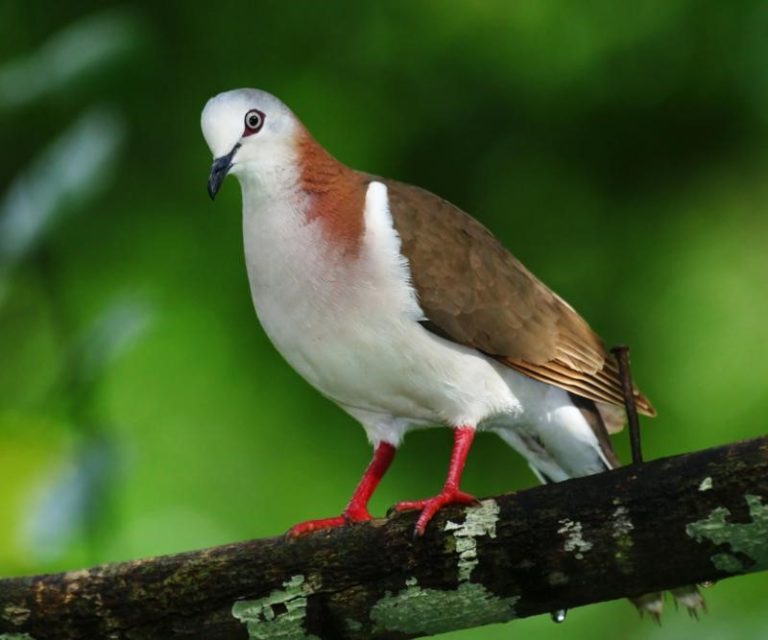
“Red-necked Dove,” L. j. jamaicensis, showing rich rufous-red coloration on the sides of the neck, and bright coral-red legs. (Rocklands Bird Sanctuary, Jamaica; July 2, 2011.) © Dave Irving
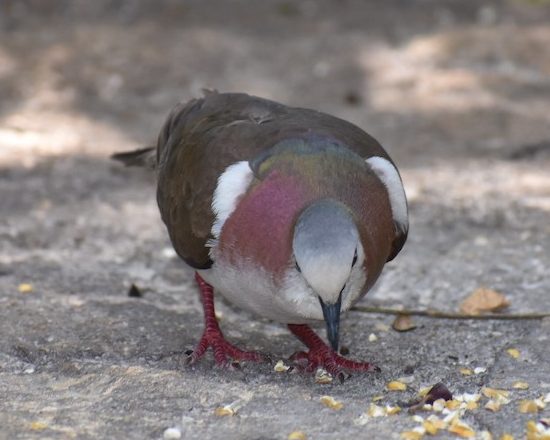
“Red-necked Dove,” L. j. jamaicensis, showing the full spectrum of iridescence on the neck and back, and prominent white bars on the sides of the chest, which differentiate it from other forms of Caribbean Dove. (Rocklands Bird Sanctuary, Jamaica; July 22, 2018.) © Hannah Leabhart
Collaris, of the Cayman Islands, has the same pattern as jamaicensis but the neck coloration is browner, more rufous than red, and the iridescence on the sides of the neck is more coppery, less rose or magenta.
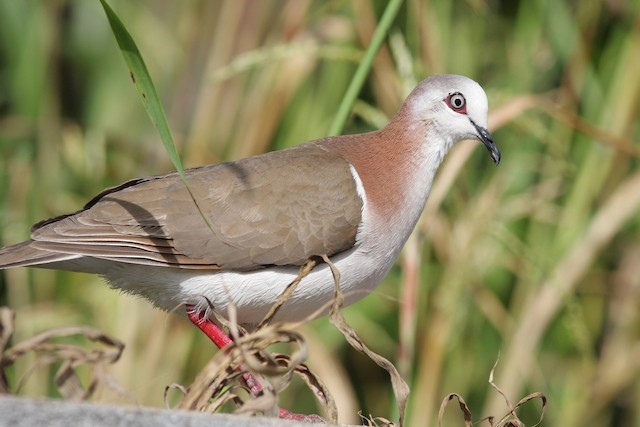
“Red-necked Dove,” L. j. collaris, showing rufous neck coloration. (Willie Ebanks’ Farm, Grand Cayman; May 12, 2008.) © Marbry Hopkins

“Red-necked Dove,” L. j. collaris, showing rosy iridescence over rufous coloration on sides of neck. (Willie Ebanks’ Farm, Grand Cayman; May 12, 2008.) © David Disher
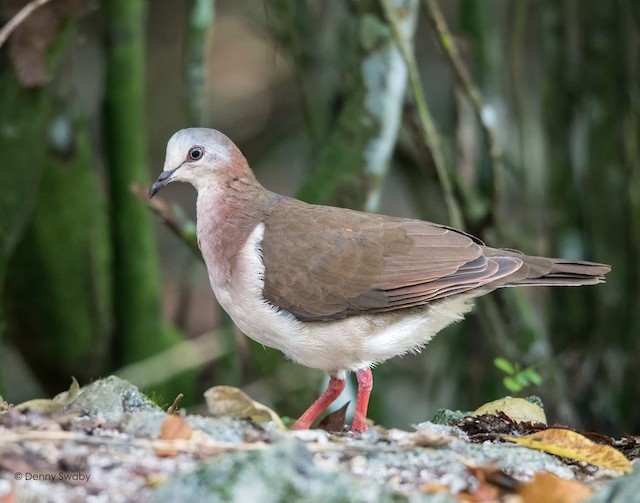
“Red-necked Dove,” L. j. collaris, showing mostly brownish neck with slight reddish tinge, and prominent white bar on the side of the chest. (Canaan Land Road, Grand Cayman; September 24, 2016.) © Denny Swaby
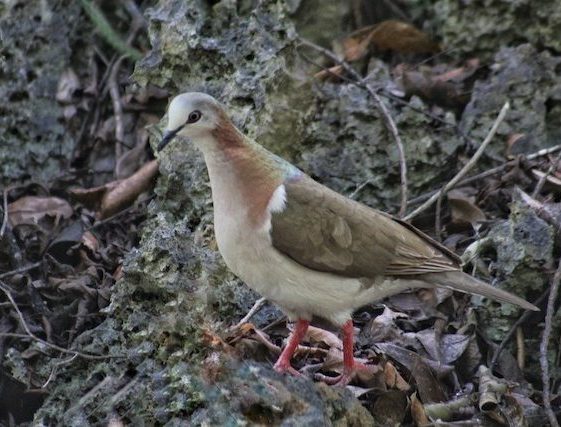
“Red-necked Dove,” L. j. collaris, showing coppery iridescence on the sides of the neck, with bronze, green, and blue on the upper back. (Mastic Trail, Grand Cayman; April 3, 2018.) © Eliza Wein
Voice. As with plumage, the forms of Caribbean Dove show significant variation in voice. The typical call of the “Red-necked Dove,” both jamaicensis and collaris, is a mournful three-note phrase with the middle note shorter and the final note drawn out: cooo-coo-coooo.
Notes
Polytypic species consisting of four recognized subspecies that comprise three distinct forms (as explained below):
“Red-necked Dove,” jamaicensis (Jamaica and New Providence) and collaris (Cayman Islands);
“Yucatán Dove,” gaumeri (Yucatán Peninsula and adjacent islands, including the Bay Islands); and
“San Andrés Dove,” neoxena (Isla San Andrés).
Frontiers of Taxonomy: Caribbean Dove.
The Caribbean Dove (Leptotila jamaicensis) includes four well differentiated subspecies that are geographically isolated and evidently diverging toward full speciation. Thus far, taxonomic authorities have not emphasized the remarkable differences among them—differences that seem facially sufficient to merit the recognition and awareness that individual common names confer.
Pending further research, I suggest provisional recognition of three distinct forms of Caribbean Dove:
“Red-necked Dove,” L. j. jamaicensis (including collaris): The two subspecies native to Jamaica and the Cayman Islands are mostly similar to one another in plumage and voice. Both have a bold white bar on the side of the chest and a contrasting reddish swath on the nape and sides of the neck that gleams with iridescence: rosy (varying from magenta to coppery) on the sides and yellow, green, and blue on the back. Both primarily sing a monotone three-note call.
“Yucatán Dove,” L. j. gaumeri: The subspecies native to the Yucatán Peninsula and Honduran Bay Islands differs from jamaicensis and collaris in its basic plumage pattern, as it has no white bar on the side of the chest and its neck is far less colorful and contrasty—it has only a slight reddish tone, but is similarly iridescent and gleams with approximately the same colors as on jamaicensis and collaris. It primarily sings a four-note call with inflected phrasing. Gaumeri is notably variable in appearance and vocalizations.
“San Andrés Dove,” L. j. neoxena: The subspecies confined to Isla San Andrés differs from the others in plumage pattern and color, as it has no white bar on the side of the chest and its neck is plain grayish-brown, with a smaller iridescent patch that is yellow, green, and blue—entirely lacking the red tones that predominate on the other forms. It primarily sings a four-note call with inflected phrasing. Neoxena appears to be little-studied, with only a handful of publicly available photographs and recordings. In light of its tiny range and shrinking habitat area, it is likely nearing extinction.

“Red-necked Dove,” L. j. jamaicensis. © Ignacio Yúfera

“Yucatán Dove,” L. j. gaumeri. © Jim Stasz
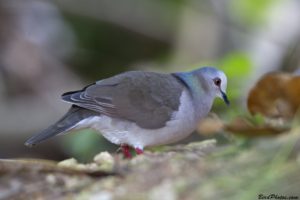
“San Andrés Dove,” L. j. neoxena. © Tom Friedel
References
Baptista, L.F., P.W. Trail, H.M. Horblit, and P. Boesman. 2018. Caribbean Dove (Leptotila jamaicensis). In Handbook of the Birds of the World Alive (J. del Hoyo, A. Elliott, J. Sargatal, D.A. Christie, and E. de Juana, eds.). Lynx Edicions, Barcelona. https://www.hbw.com/node/54236. (Accessed January 13, 2018.)
eBird. 2019. eBird: An online database of bird distribution and abundance. Cornell Lab of Ornithology, Ithaca, N.Y. http://www.ebird.org. (Accessed January 18, 2019.)
Fagan, J., and O. Komar. 2016. Peterson Field Guide to the Birds of Northern Central America. Houghton Mifflin Harcourt, New York.
Gibbs, D., E. Barnes, and J. Cox. 2001. Pigeons and Doves: A Guide to the Pigeons and Doves of the World. Yale University Press, New Haven, Connecticut.
Haynes-Sutton, A., A. Downer, R. Sutton, and Y.-J. Rey-Millet. 2009. A Photographic Guide to the Birds of Jamaica. Princeton University Press, Princeton, N.J.
Howell, S.N.G. and S.W. Webb. 1995. A Guide to the Birds of Mexico and Northern Central America. Oxford University Press, Oxford.
McMullan, M., and T. Donegan. 2014, Field Guide to the Birds of Colombia (Second Edition). Fundación Proaves de Colombia, Bogotá.
Raffaele, H., J. Wiley, O. Garrido, A. Keith, and J. Raffaele. 1998. A Guide to the Birds of the West Indies. Princeton University Press, Princeton, N.J.
